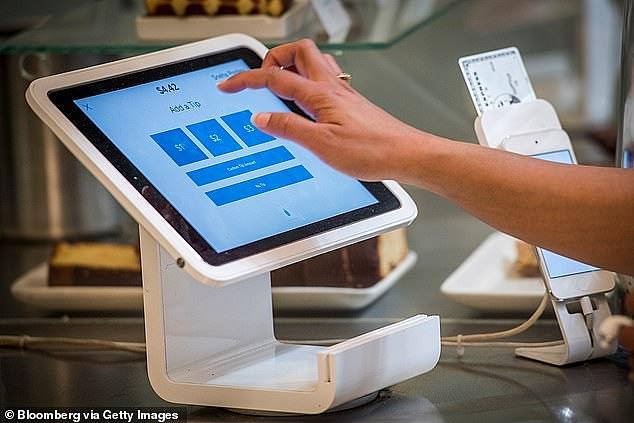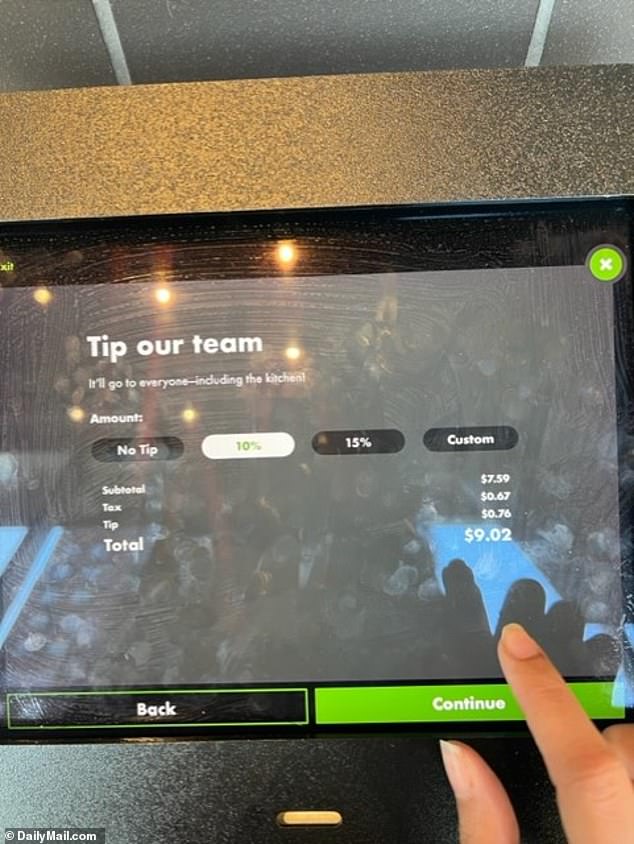The sneaky trick American businesses are using to get extra tips: Square payment expert reveals how suggested amounts on gratuity screens are being increased
An expert on the Square ‘tipping screen’ payment system claims that US companies are using it to give employees extra tips in a world where many believe they are suffering from ‘tipflation’.
In September, it was revealed that nearly three-quarters of Americans tip higher when presented with a digital screen at checkout, a new report shows.
Many base their tips on the pre- or post-tax subtotal based on local sales taxes, with pre-tax tips not accounting for those high rates in what servers take home.
That also plays a role in what Square, the most prominent makers of the tilting screen, offer customers.
“Sellers decide whether tips are calculated before or after taxes,” a company spokesperson said, noting that they also allow custom tips.
After-tax tippers may pay the highest among the five states with the highest average state and local sales tax rates – led by Tennessee and Louisiana at 9.55 percent, followed by Arkansas (9.44 percent), Washington (9.40) and Alabama (9.24).
After-tax tippers may pay the highest among the five states with the highest average state and local sales tax rates – led by Tennessee and Louisiana at 9.55 percent, followed by Arkansas (9.44 percent), Washington (9.40) and Alabama (9.24).
In contrast, Alaska, Oregon, New Hampshire, Montana and Delaware have no sales tax.
According to the Fort Worth Star-Telegram, the restaurant in question can set its policy on the pre-tax total or on the entire bill if it wants its employees to take home more.
The Emily Post Institute, a group of etiquette experts, says wait staff should be given a pre-tax tip of 10 to 20 percent, while 10 percent for takeout orders or on-time delivery is appropriate but not required.
About 73 percent of people said they tipped at least 11 percent higher with digital tipping than with cash.
The study from Forbes Advisor also found that 31 percent of people admitted to feeling “pressured” to tip for a range of services ranging from sit-down meals and coffee to taxis.

An expert on the Square ‘tipping screen’ payment system claims US companies are using them to give workers extra tips in a world where many believe they are suffering from ‘tipflation’
It comes as more than half of Americans believe we’re living in an era of ‘tipflation’ – with two in five people blaming the popular iPad checkout screens for this trend, according to an exclusive DailyMail.com survey earlier this year.
Americans are increasingly being presented with requests for tips, and prompts are forthcoming bars and restaurants, but also in shops, takeaway chains and even self-service vending machines.
So-called “tipflation” has been caused in part by the mass adoption of iPad checkout screens that offer customers the chance to add tips.
Such systems became hugely popular during the pandemic when retailers stopped accepting cash over fears banknotes could spread Covid-19.
And according to the latest research from Forbes Advisor, the constant prompts are making people tip more.
It showed that 22 percent of people tipped between 11 and 15 percent more, while 21 percent of people tipped between 16 and 20 percent more.
According to the findings, 14 percent added 21 to 25 percent more to purchases as a result of being shown a digital screen.
One in three people feel pressured to tip, the survey found, while 18 percent admit it makes them feel ‘uncomfortable’.

Many base their tips on the pre- or post-tax subtotal based on local sales taxes, with pre-tax tips not accounting for those high rates in what servers take home
Nearly a quarter of people also say it makes them feel ‘ashamed’ or ‘guilty’.
However, not all respondents were negative about adding tips, the survey found. 36 percent said it made them feel “happy,” and 33 percent said it made them feel “grateful.”
When it comes to the services people are most likely to tip for, restaurant servers top the list; 58 percent of respondents say they tip after a meal.
About 46 percent said they would tip food delivery workers, and 39 percent said they would typically tip at a bar.
However, only 20 percent said they would tip for child care, and only 17 percent said they would give extra to movers.
A separate survey earlier this year found that Americans were becoming “stingier” with their tipping behavior.
Bankrate’s research shows that the number of people who always tip servers at a restaurant has decreased by 12 percent over the past four years — from 77 percent in 2019 to 65 percent in 2023.
Ted Rossman, senior industry analyst at Bankrate, told Dailymail.com at the time: ‘Inflation and general economic turmoil seem to be making Americans stingier with their tipping habits, yet we are faced with more invitations to tip than ever.
“While many people said they would tip more generously during the pandemic as there was a groundswell of support for service sector workers continuing to show up for work, that enthusiasm is not here to stay.
“There’s also been a lot of talk about tipping: being asked to tip for things that historically didn’t warrant a tip. I’ve seen tip requests at self-checkouts and when booking travel online. This is blatant revenue theft.”
